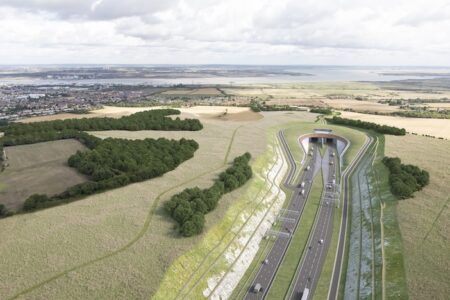The Northwest Seaport Alliance (NWSA) will launch two new mobile applications in early November to help speed the flow of containers through port facilities and along local freight corridors, reduce idling-related air emissions, and save fuel.
The NWSA is a marine cargo operating partnership of the ports of Seattle and Tacoma in the state of Washington. The combined ports are the fourth-largest container gateway in North America. The DrayQ app aims to give truck drivers real-time information about wait times in and around marine cargo terminals, and the DrayLink app will interconnect the drayage community to better dispatch, track and record container moves from pickup to delivery. The apps were designed specifically for, and in partnership with, the port industry to align with the US Department of Transportation’s (USDOT) connected vehicle Freight Advanced Traveler Information System (FRATIS) architecture and StrongPorts initiative.
DrayQ (below) is the first mobile app in the market to use Bluetooth technology to provide real-time estimates of drayage truck wait times at ports and terminals. The app also provides trend information and traffic camera views at the touch of a fingertip. Drivers can use the app to determine the optimum time to enter a terminal and reduce the time spent in traffic, which helps reduce air emissions from idling and saves fuel. For dispatchers or shippers, it helps to optimize schedules and improve customer expectations.
The second app, DrayLink, is designed to help interconnect the drayage community by offering a single common operating tool for drivers, dispatchers, terminal operators and shippers to help move containers smarter. Like DrayQ, DrayLink also provides real-time information on street and terminal wait times, but offers greater functionality using the power of Google Analytics, GPS data, and geofencing that enables users to track and record cargo moves and generate useful tailored reports. Working with Google, DrayLink plans to use their Map API Engine for wait-time predictions and trends.
Drivers using DrayLink can view wait time information in real time in the same common format as DrayQ. Wait times are determined when the driver’s smartphone reporting GPS data passes through predefined geofences set in the streets leading to the terminal entry, within the terminal boundaries and also at any set ‘geofences within geofences’, so that specific times within areas of a terminal yard can be monitored and recorded.
DrayLink also has the ability to receive and aggregate various sources of data feeds, such as GPS from fleet vehicles already equipped with devices, other third-party smartphone GPS apps, Bluetooth and wi-fi sensing, and RFID or toll-tag data. Aggregating this available data benefits the drayage community by improving data quality and reporting accuracy.
“DrayLink provides a single robust platform using the FRATIS model so that dispatchers and terminal operators can more effectively collaborate to better manage drayage movements,” said Ron Stuart, NWSA’s DrayQ project manager.
“For shippers, DrayLink provides a way to automate tracking, tracing, and reporting notifications that improves overall in-transit visibility for cargo owners. For terminal operators, DrayLink can provide advanced arrival info and credential checks for faster gate transactions.”




